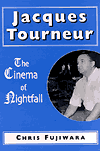The New Historical Dictionary of the American Film
Anthony Slide
Scarecrow Press,
266 pps., hardback, $55
[ Buy this book through www.amazon.com ]
An abundance of tomes about "Who's Who" in the movie industry has been published over the years, but this reference guide is more of a "What's What." The difference is all good, because the guide offers a handy reference to many subjects that would ordinarily require a great deal of research. For instance, this is the place to look if one wanted to know something about the Aywon Film Corporation or Prizma Color. There's also bibliography where further information on each topic can be found.
Arranged alphabetically are more than 800 subjects, including production and distribution companies (many are long-vanished entities such as Grand National, Mascot, Draco, etc.), industry guilds and organizations, important location sites, film labs, color processes, wide-screen processes, industry terms, technical innovations, genres, techniques and some surprising odds and ends.
This is an updated and greatly expanded version of Slide's landmark 1986 reference work The American Film Industry: A Historical Dictionary. The latest version, with more than 200 new entries and much revision, is an even better job — cold facts are written with understanding. There are even occasional flashes of humor, as when Slide explains that "Alan Smithee" is a substitute name used when a director doesn't want a credit, and then lists several films attributed to Smithee. He concludes: "The 1997 production An Alan Smithee Film became an 'Alan Smithee' film when its director, Arthur Hiller, asked for his name to be removed."
Smile When the Raindrops Fall: The Story of Charlie Chase
Brian Anthony and Andy Edmonds
Scarecrow Press,
283 pps., Cloth. $49.95
[ Buy this book through www.amazon.com ]
During the silent-film era, a considerable number of comedians plied their trade in the movies, mostly in short subjects. The public loved these shows, but the critics and intellectuals turned a cold shoulder to most, dismissing them with denigrating terms — "slapstick" and "low-brow" being chief among them. The only silent comedian who really rang the highbrows' bell was Charles Chaplin, sometimes referred to as "the only real genius on the screen." Genius yes, but far from alone. Eventually, pundits admitted that Buster Keaton and Harold Lloyd were also doing some nice work, earning them positions in the pantheon at the master's feet. Most others (including the popular favorites, Laurel and Hardy), were virtually ignored for decades, until it became too late for them to enjoy the fruits of their gifts — whereupon, suddenly, their genius became apparent. As more "sophisticated" verbal comedy became the rage, not many cinema clowns survived the "talkies," except as supporting players.
Charley Chase (1892-1940) is one of the great old-time comics who was touched by the cruel hand of genius but whose acceptance among the arbiters of taste was delayed until a half-century after his death. Now there is a biography, written con amor by a pair of excellent researchers whose affection for their subject is evident. The book is also an impressive filmography.
Chase, whose real name was Parrott, was born in Baltimore and was working in vaudeville when he came to Hollywood in 1912. As a triple-threat actor/director/writer for Mack Sennett and, later, at Hal Roach and Columbia, he became an important influence in screen comedy. The careers of Laurel and Hardy, Thelma Todd, The Three Stooges and many others were influenced by Chase. After "talkies" arrived, he added singing, tap dancing and songwriting to his repertoire. Chase's onscreen persona was tall, thin and full of mischief. Offscreen, his tragic burdens included alcoholism and futile attempts to help his narcotics-addicted younger brother, Jimmy — himself a brilliant director gone to seed.
Plenty of rare photographs abound in this long-deserved, fine biography of Charley Chase.
Jacques Tourneur: The Cinema of Nightfall
by Chris Fujiwara
Foreword by Martin Scorsese
McFarland & Co.,
328 pps., hardback, $42.50
[ Buy this book through www.amazon.com ]

It's strange that Jacques Tourneur, a brilliant director of unusual sensitivity and taste, has never received greater recognition. Perhaps it's because some of his most distinguished work was done in the shadows of others. His father was the revered French director Maurice Tourneur, who also made important films in America. Though a great filmmaker, Maurice was a distant and rather cruel father. Even his worshipful assistant, Clarence Brown, had to admit, "He was cold. He had no heart." Jacques worked as a bit player and script clerk in Hollywood in the 1920s, but later returned to France, where he edited some of his father's films and directed four features.
After returning to Hollywood in 1934, he found work at MGM as a second-unit director, most notably as the man behind the storming of the Bastille in A Tale of Two Cities. He directed 20 of MGMs celebrated dramatic short subjects from 1936-42; these were little gems, but charismatic narrators such as John Nesbitt and Pete Smith got the glory. Tourneur finally broke into feature direction. His fifth effort was RKO's modestly budgeted Cat People (1943), which was followed by I Walked with a Zombie and The Leopard Man. Even with these widely praised films, Tourneur was largely obscured by the shadow of the producer, Val Lewton. Still, the success of these pictures kicked Tourneur upstairs to bigger-budget shows, including Experiment Perilous, Canyon Passage, Out of the Past, Berlin Express, Wichita, Nightfall, and Night of the Demon.
Fujiwara has written a fine tribute to Tourneur, combining biography with close scrutiny of his films. Stylistic links between the projects are explored, beginning with the earliest examples. Even the short subjects and television episodes are given expansive coverage with full casts and credits.
[ Go to the top ]